For affordable wedding photography and videography backups, you've got several options. Start with cloud storage like Google Drive or Dropbox for off-site protection. Pair this with portable external hard drives for quick, on-the-go backups. Use redundant camera systems and multiple memory cards to minimize risk during shoots. Implement on-site backup strategies, including dual card slots and periodic transfers. Consider offsite storage for added security, and explore wireless transfer technologies for real-time backups. Don't forget temporary backup solutions during events. With these strategies, you'll create a robust system to safeguard your clients' precious memories. Dive deeper to discover how to optimize each method for your specific needs.
Key Takeaways
- Cloud storage services like Google Drive or Dropbox offer affordable, reliable off-site backup options with automatic syncing.
- Portable external hard drives provide cost-effective, on-the-go storage without internet dependency.
- Dual card slots in cameras create instant backups without additional equipment costs.
- NAS systems with RAID configurations offer centralized, redundant storage for larger operations.
- Online gallery platforms like Pixieset combine secure storage with client sharing features at competitive prices.
Cloud Storage Solutions
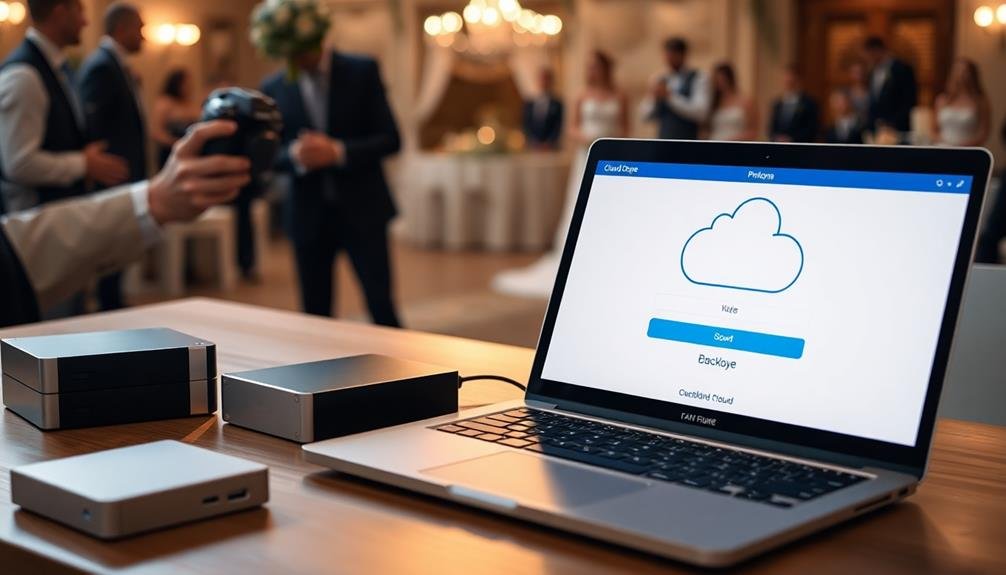
Cloud storage offers a lifeline for wedding photographers seeking reliable backup solutions. You'll find numerous affordable options that provide secure, off-site storage for your precious wedding files. Popular choices include Google Drive, Dropbox, and iCloud, which offer varying storage capacities and pricing plans to suit your needs.
When selecting a cloud storage solution, consider factors like storage space, ease of use, and sync speed. Look for providers that offer automatic backups and version history, allowing you to recover previous file versions if needed. Many services also provide file sharing capabilities, making it easy to deliver images to clients.
For wedding photographers handling large file sizes, consider specialized photography-focused cloud storage services like Backblaze or Crashplan. These offer unlimited storage and are designed to handle high-resolution images and video files efficiently.
Don't forget to implement a multi-tiered backup strategy. Use cloud storage in conjunction with local backups on external hard drives or network-attached storage (NAS) devices. This approach guarantees you have multiple copies of your files stored in different locations, minimizing the risk of data loss due to hardware failure or unforeseen circumstances.
Portable External Hard Drives

Why rely solely on cloud storage when portable external hard drives offer a tangible and efficient backup solution for wedding photographers? These compact devices provide quick access to your files without an internet connection, making them ideal for on-the-go backups during shoots.
When choosing a portable external hard drive, consider factors like storage capacity, transfer speed, durability, and price. Opt for drives with at least 2TB of space to accommodate high-resolution photos and videos. Look for USB 3.0 or higher connectivity for faster data transfers. Ruggedized models offer extra protection against drops and environmental factors, essential for outdoor weddings.
| Brand | Capacity | Speed | Durability |
|---|---|---|---|
| WD Elements | 2TB | USB 3.0 | Standard |
| Seagate | 4TB | USB 3.0 | Rugged |
| SanDisk | 1TB | USB 3.1 | Water-resistant |
| LaCie | 5TB | Thunderbolt 3 | Shock-resistant |
To maximize reliability, use multiple drives and rotate them regularly. Always keep one drive off-site to protect against theft or disasters. Implement a naming convention for your backups to easily locate specific wedding files. Remember to test your drives periodically to verify they're functioning correctly and your precious memories remain safe.
Redundant Camera Systems
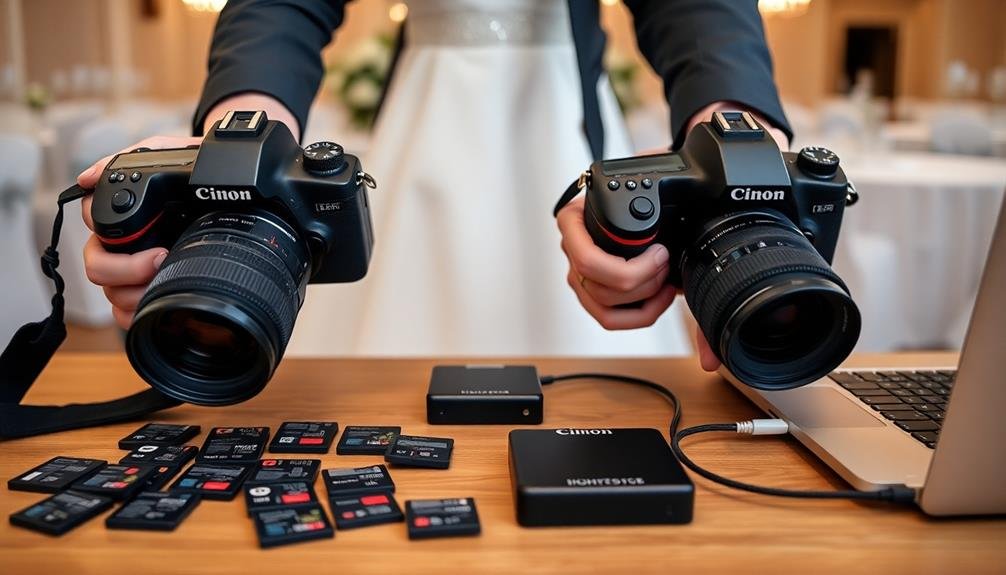
While portable hard drives offer reliable storage, they can't capture the moment if your primary camera fails. That's where redundant camera systems come in. As a wedding photographer or videographer, you should always have a backup camera ready to go.
Consider carrying a second camera body of the same make and model as your primary. This allows you to quickly switch without adjusting to different controls. If that's not feasible, opt for a less expensive but still capable backup camera.
Don't forget about lenses. Bring duplicates of your most essential focal lengths. A 24-70mm and 70-200mm pair can cover most wedding scenarios. For video, pack an extra wide-angle lens and a portrait lens.
Ensure all your cameras use the same memory card type for easy swapping. Carry plenty of spare batteries and chargers. Test your backup gear regularly to guarantee it's in working order when you need it.
Lastly, consider partnering with another photographer or videographer. You can act as each other's backup, sharing equipment if necessary. This approach provides peace of mind and potentially enhances your coverage of the event.
Memory Card Management

When managing memory cards for wedding photography, you'll need to take into account storage capacity carefully.
Guarantee you have enough cards to capture the entire event without running out of space.
Format your cards before the wedding and organize them systematically to prevent confusion and potential data loss during the hectic day.
Storage Capacity Considerations
Throughout your wedding day, you'll be capturing countless precious moments, making storage capacity a crucial consideration for backup photography. Make sure you have enough storage to accommodate all the photos and videos you'll take. For a typical 8-hour wedding, you might need anywhere from 64GB to 128GB of storage, depending on your camera's resolution and file formats.
Consider using multiple smaller capacity cards instead of one large card. This strategy reduces the risk of losing all your photos if a single card fails. Aim for 32GB or 64GB cards, which offer a good balance between capacity and risk management.
Don't forget to factor in RAW files if you shoot in this format, as they take up considerably more space than JPEGs. Also, if you're offering same-day slideshows or quick turnaround edits, bring extra storage for these processed files.
Lastly, always pack more storage than you think you'll need. It's better to have excess capacity than to run out mid-event. Consider bringing at least 1.5 times your estimated storage needs to account for unexpected situations or extended coverage.
Formatting and Organization
Proper memory card management is essential for efficient wedding photography backup. Start by formatting your memory cards before each event using your camera's built-in formatting function. This guarantees peak performance and reduces the risk of data corruption.
Organize your cards systematically. Use a dedicated card case and label each card with a unique identifier. As you shoot, rotate cards frequently to distribute data across multiple cards, minimizing the impact of potential card failure.
When importing images, create a consistent folder structure on your computer. Use a naming convention that includes the date, couple's names, and event type. For example: "2023-05-15_Smith-Jones_Wedding".
Within this folder, create subfolders for different parts of the day, such as "Ceremony," "Portraits," and "Reception."
During import, apply metadata tags to your images, including client information, location, and relevant keywords. This makes searching and organizing your files easier in the long run.
After importing, verify that all images have transferred correctly before formatting your cards for the next event. Always keep at least one backup copy of your files on a separate device or cloud storage service.
On-Site Backup Strategies
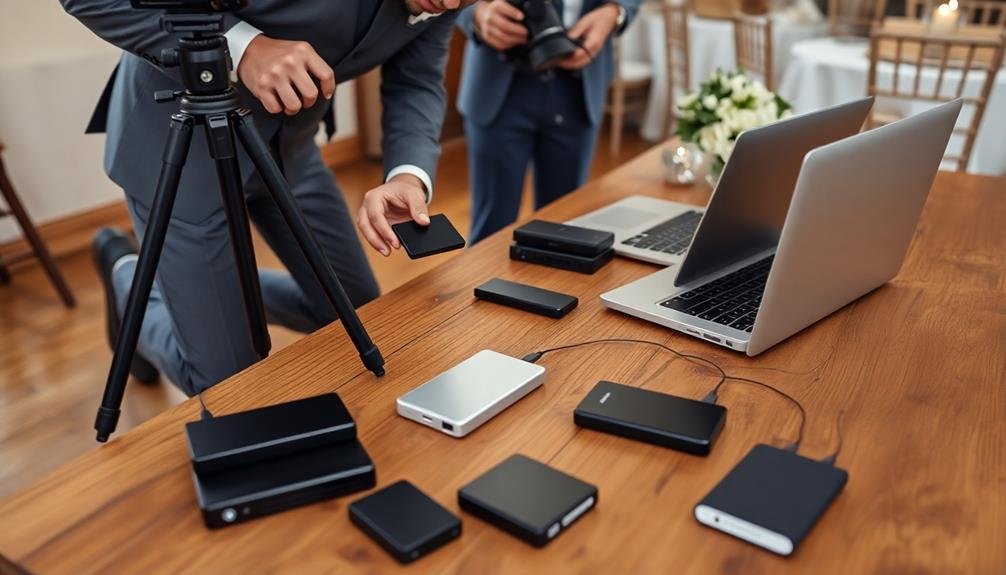
You can safeguard your wedding photos on-site using multiple backup methods.
Start by utilizing redundant memory cards in your camera, ensuring you have duplicate copies of each image as you shoot.
Consider bringing a portable hard drive to transfer files periodically throughout the event, and explore cloud-based solutions that allow real-time uploads for immediate off-site storage.
Redundant Memory Card Usage
One of the most essential on-site backup strategies for wedding photographers is using redundant memory cards. This technique involves utilizing cameras with dual card slots to simultaneously record images to two separate cards. By doing so, you're creating an instant backup of every shot you take.
When implementing this strategy, opt for high-quality, reliable memory cards from reputable brands. Use cards with different capacities or from different manufacturers to reduce the risk of both failing simultaneously. Set your camera to write RAW files to one card and JPEGs to the other, or configure it to mirror the same data on both cards.
Remember to regularly check your cards throughout the event to verify they're functioning correctly. Always carry extra memory cards in case of unexpected failures or if you need additional storage.
At the end of the wedding, keep the redundant cards separate when transporting them to minimize the risk of losing both copies.
Portable Hard Drive Solutions
While redundant memory cards offer immediate backup, portable hard drives provide an additional layer of on-site protection for your wedding photos. These compact devices allow you to transfer images from your camera or memory cards throughout the day, ensuring you have a second copy of your work before leaving the venue.
Choose a rugged, shock-resistant portable hard drive with ample storage capacity. Aim for at least 1TB to accommodate high-resolution photos and videos. Solid-state drives (SSDs) are faster and more durable than traditional hard disk drives (HDDs), but they're pricier. If budget is a concern, a reliable HDD will suffice.
During breaks or downtime, connect your camera or card reader to the portable drive and transfer your files. Some photographers use a laptop as an intermediary, which allows for quick image previews and organization. However, this method requires more equipment and setup time.
To streamline your workflow, consider drives with built-in card readers or Wi-Fi capabilities. These features enable faster transfers and reduce the need for additional cables or adapters.
Remember to keep your portable drive in a safe, easily accessible location throughout the event.
Cloud-Based Real-Time Uploads
Cloud-based real-time uploads offer a cutting-edge solution for on-site wedding photo backups. As you shoot, your images are instantly transferred to secure cloud storage, providing peace of mind and eliminating the risk of data loss.
This method requires a reliable internet connection, so always check the venue's Wi-Fi capabilities or bring a mobile hotspot.
Popular cloud services like Dropbox, Google Drive, or specialized photography platforms offer automatic upload features. Set up your camera or tethered device to send photos directly to these services as you capture them.
Many professional cameras now come with built-in Wi-Fi capabilities, making this process even smoother.
Consider using a service that offers version control and redundancy. This guarantees you have multiple copies of each image and can easily revert to earlier versions if needed.
Some platforms also provide automatic RAW file conversion, saving you time in post-processing.
While cloud-based solutions can be more expensive than physical storage options, they offer unparalleled convenience and security.
Look for plans with ample storage space and fast upload speeds to accommodate large photo files and guarantee smooth operation during busy wedding shoots.
Networked Attached Storage (NAS)
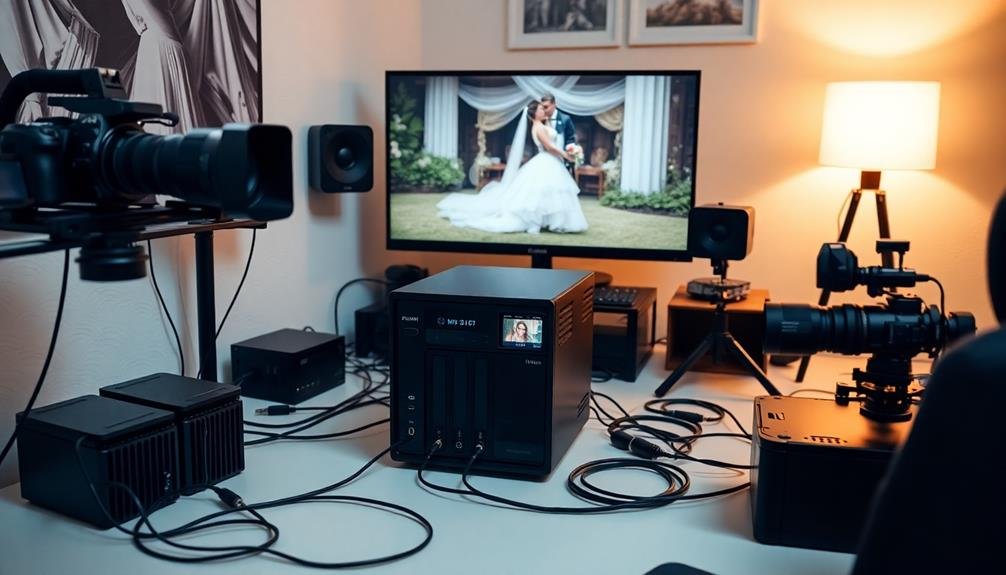
Reliability meets affordability with Networked Attached Storage (NAS) systems for wedding photography backup. NAS devices connect to your local network, allowing you to store and access files from multiple computers. They're ideal for wedding photographers who need a centralized storage solution that's accessible from various devices.
You'll find NAS systems offer several advantages. They provide redundancy through RAID configurations, protecting your data if a drive fails. Many NAS devices support automatic backups, ensuring your wedding photos are safely stored without manual intervention. You can also set up remote access, allowing you to retrieve files when you're away from your studio.
When choosing a NAS for wedding photography backup, consider factors like storage capacity, expandability, and ease of use. Look for models with at least two drive bays for RAID functionality. Popular brands like Synology and QNAP offer user-friendly interfaces and apps that simplify file management.
While NAS systems require an initial investment, they're cost-effective in the long run. You'll avoid ongoing cloud storage fees and have full control over your data.
Plus, you can expand storage as your business grows, making NAS a scalable solution for your wedding photography backup needs.
RAID Array Configurations

RAID array configurations offer powerful data protection options for wedding photographers.
You'll need to understand different RAID levels, their advantages and disadvantages, and which setups are most suitable for your workflow.
Let's explore RAID levels, weigh their pros and cons, and identify recommended configurations for wedding photography backups.
RAID Levels Explained
Occasionally, photographers encounter the term RAID when exploring backup options for their wedding photos. RAID stands for Redundant Array of Independent Disks and offers various levels of data protection and performance enhancement. Understanding these levels can help you choose the best configuration for your needs.
Here's a quick overview of common RAID levels:
| RAID Level | Minimum Disks | Data Protection | Performance |
|---|---|---|---|
| RAID 0 | 2 | None | Excellent |
| RAID 1 | 2 | Good | Good |
| RAID 5 | 3 | Good | Good |
| RAID 10 | 4 | Excellent | Excellent |
RAID 0 offers no data protection but provides the best performance by striping data across disks. RAID 1 mirrors data for redundancy, while RAID 5 distributes data and parity information across disks. RAID 10 combines mirroring and striping for both high performance and excellent data protection.
When choosing a RAID level, consider your budget, storage needs, and desired level of data protection. For wedding photographers, RAID 1 or RAID 5 often provide a good balance of performance and data safety. Remember, RAID isn't a substitute for off-site backups, but it can be an essential part of your overall data protection strategy.
Pros and Cons
Building on our understanding of RAID levels, let's explore the advantages and drawbacks of different RAID array configurations for wedding photographers.
RAID 0 offers improved performance and increased storage capacity but lacks redundancy. It's ideal for temporary storage or when speed is essential, but risky for long-term data storage.
RAID 1 provides excellent data protection through mirroring but halves your available storage space. It's perfect for vital client files but can be costly for large photo collections.
RAID 5 balances performance, capacity, and redundancy, making it popular among photographers. You'll benefit from improved read speeds and data protection, but write speeds may suffer.
RAID 6 enhances data security with dual parity, protecting against two drive failures. However, it's more expensive and has slower write speeds than RAID 5.
RAID 10 combines the benefits of RAID 0 and 1, offering excellent performance and redundancy. It's ideal for mission-critical data but requires a minimum of four drives, making it costly.
Consider your budget, storage needs, and risk tolerance when choosing a RAID configuration for your wedding photography business.
Recommended RAID Setups
When it comes to choosing the right RAID setup for your wedding photography business, several configurations stand out as particularly effective.
RAID 1 offers excellent data redundancy by mirroring your data across two drives, ensuring you'll have a backup if one drive fails.
For those needing more storage capacity and improved performance, RAID 5 provides a good balance of speed, capacity, and redundancy using at least three drives.
If you're looking for maximum performance and data protection, consider RAID 10, which combines the benefits of RAID 1 and RAID 0. It offers both mirroring and striping, providing excellent read/write speeds and fault tolerance.
For larger storage needs, RAID 6 offers enhanced data protection by allowing two drive failures without data loss.
When selecting your RAID setup, consider these factors:
- Storage capacity requirements
- Budget constraints
- Performance needs
- Desired level of data redundancy
Online Gallery Platforms
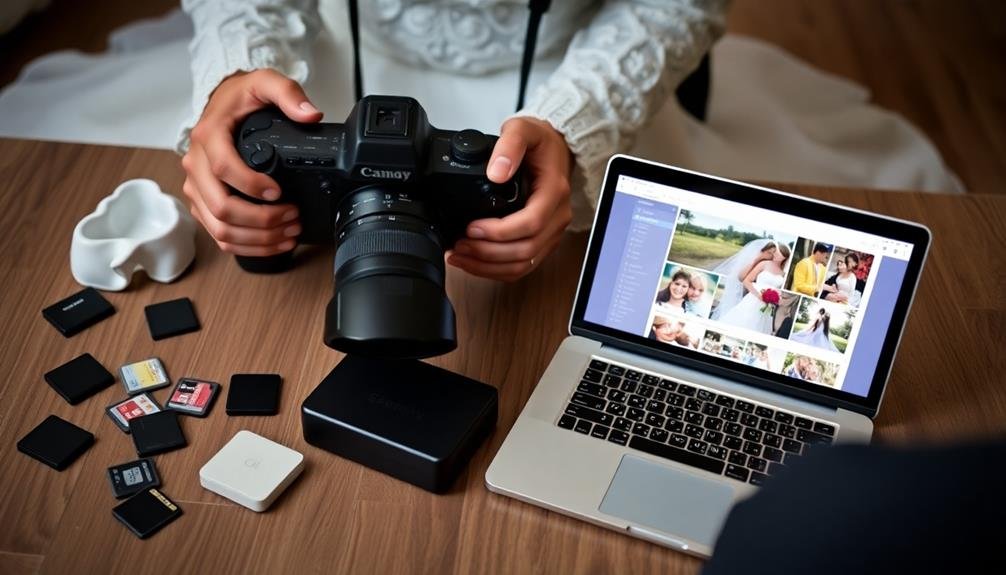
Online gallery platforms offer a secure and convenient way to store and share your wedding photos. These platforms provide an additional layer of backup while also serving as a delivery method for your clients. Popular options include Pixieset, ShootProof, and Pic-Time.
When choosing an online gallery platform, consider factors like storage capacity, ease of use, and pricing. Most platforms offer tiered plans based on the amount of storage you need. Look for features such as client proofing, direct print ordering, and customizable galleries to enhance your service offerings.
Many platforms integrate with editing software like Lightroom, streamlining your workflow. They also often include mobile apps, allowing you to manage your galleries on the go. Some platforms offer automatic backups to cloud storage services, further protecting your images.
Security is essential, so opt for platforms with robust encryption and access controls. Verify the platform allows you to set expiration dates for galleries and control download permissions.
Additionally, consider platforms that offer white-labeling options to maintain your brand identity throughout the client experience.
Automated Backup Software
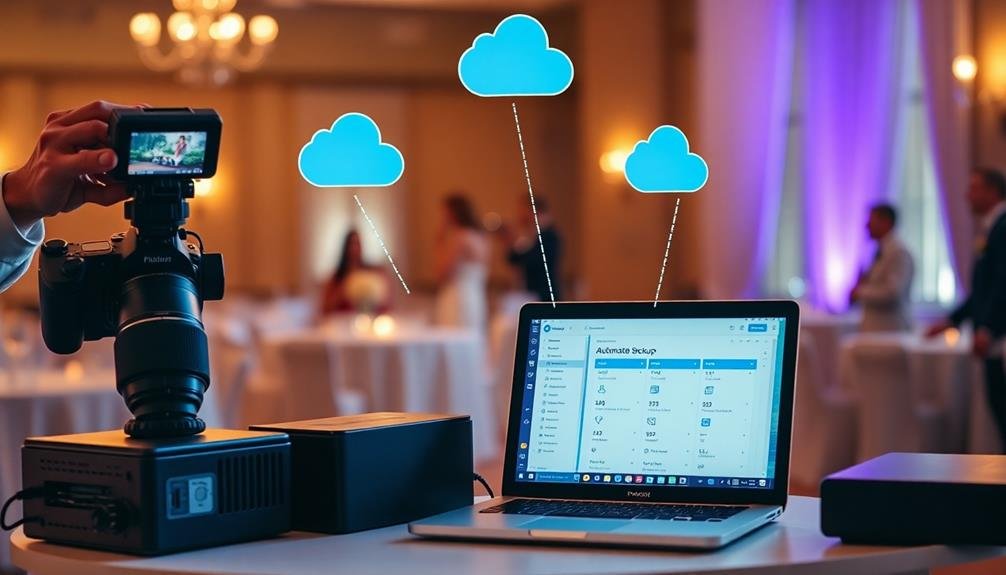
Automated backup software serves as a powerful tool in your wedding photography backup arsenal. It takes the guesswork out of file management by automatically copying your images to designated locations. You'll save time and reduce the risk of human error, guaranteeing your clients' precious memories are always protected.
When choosing automated backup software, consider options that offer:
- Real-time syncing
- Incremental backups
- Version control
- Cross-platform compatibility
Look for software that allows you to set up multiple backup destinations, including external hard drives, network-attached storage (NAS), and cloud services. This approach creates a robust, multi-layered backup system that safeguards against various potential failures.
Popular automated backup solutions for wedding photographers include Backblaze, Carbonite, and CrashPlan. These services offer continuous, automatic backups with encryption for added security. Some even provide features like remote file access and mobile app support, allowing you to manage your backups on the go.
Remember to regularly test your automated backup system to verify it's functioning correctly. Set up notifications to alert you of any issues, and periodically restore files to confirm the integrity of your backups.
Dual-Slot Camera Bodies

For wedding photographers seeking robust on-site backup solutions, dual-slot camera bodies offer an invaluable safeguard. These cameras feature two memory card slots, allowing you to simultaneously record images to both cards. This immediate redundancy protects against card failure or corruption, ensuring you don't lose precious moments from the big day.
When shooting with a dual-slot camera, you have several options. You can set it to record RAW files to one card and JPEGs to the other, providing a backup in case one file type becomes corrupted. Alternatively, you can mirror the same files to both cards for complete redundancy. Some photographers prefer to use the second slot as an overflow, automatically switching when the first card is full.
While dual-slot cameras are often pricier than single-slot models, they're a worthwhile investment for professional wedding photographers. Many mid-range and high-end DSLRs and mirrorless cameras now offer this feature.
When shopping for a dual-slot camera, consider factors like card compatibility, write speeds, and whether both slots support the fastest memory card types. By utilizing dual-slot cameras, you'll greatly reduce the risk of data loss and provide peace of mind for both you and your clients.
Offsite Storage Options

Secure offsite storage is an essential component of any thorough wedding photography backup strategy. It guarantees your clients' precious memories are protected from local disasters or theft.
Cloud storage services offer an affordable and reliable solution for offsite backups. You'll find various options tailored to photographers' needs, with ample storage space and fast upload speeds.
When choosing an offsite storage solution, consider these factors:
- Storage capacity: Confirm it can accommodate your growing portfolio
- Upload and download speeds: Look for services with fast transfer rates
- Security features: Opt for end-to-end encryption and two-factor authentication
- Pricing: Compare plans to find the best value for your budget
Popular cloud storage providers like Google Drive, Dropbox, and Amazon S3 offer competitive rates for large data volumes.
Alternatively, you can explore photography-specific services such as Backblaze or Crashplan, which provide unlimited storage options.
To maximize efficiency, set up automatic backups to your chosen offsite storage. This way, you'll guarantee all your wedding photos are securely stored off-premises without manual intervention.
Remember to regularly test your backup system to verify that your files are accessible and uncorrupted.
Wireless Transfer Technologies
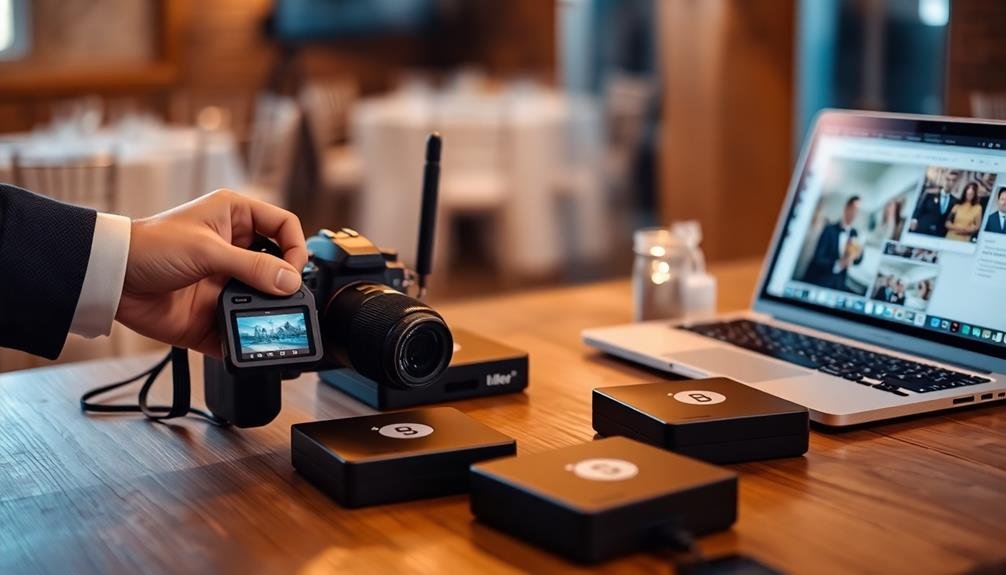
Wireless transfer technologies have revolutionized the way photographers backup and share their wedding images. You can now seamlessly transfer photos from your camera to a backup device or cloud storage in real-time, ensuring your clients' precious memories are protected instantly.
Wi-Fi-enabled cameras allow you to connect directly to your smartphone or tablet, transferring images as you shoot. Many modern cameras also feature built-in Bluetooth capabilities, enabling continuous low-power connections for automatic file transfers.
For faster transfers, consider using NFC (Near Field Communication) technology. By tapping your NFC-enabled camera to a compatible device, you can quickly initiate large file transfers without manually connecting to Wi-Fi networks.
If you're working in areas with cellular coverage, 4G or 5G-enabled cameras and memory cards can upload your photos directly to cloud storage services. This eliminates the need for intermediary devices and provides an extra layer of security.
For local transfers, you might opt for ad-hoc Wi-Fi networks or portable Wi-Fi routers. These create a secure, high-speed connection between your camera and backup devices, even in remote locations without internet access.
Temporary Backup During Events
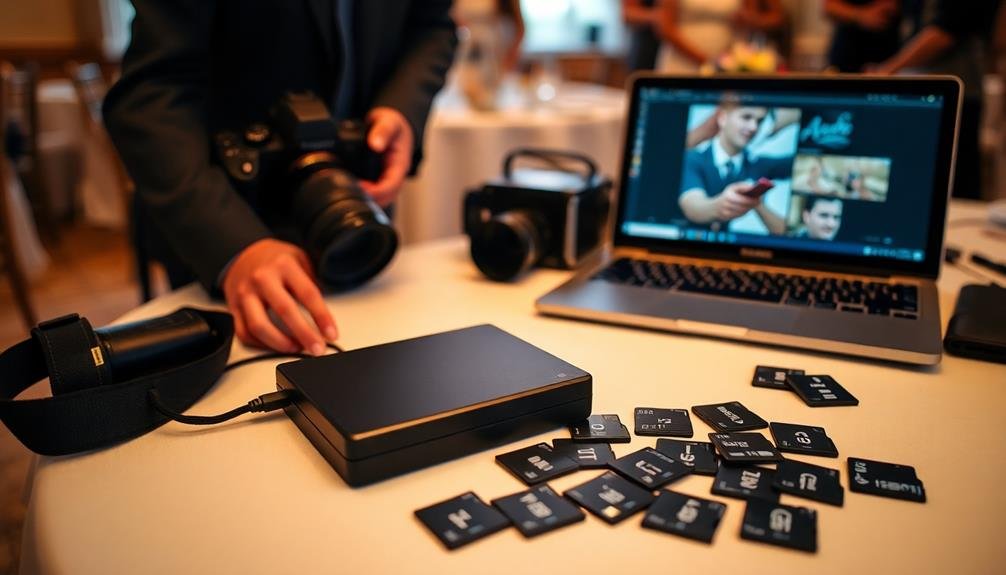
When you're shooting a wedding, on-site storage solutions can provide immediate backup for your precious photos.
Consider using portable hard drives or memory card duplicators to create copies of your images as you work.
Additionally, cloud syncing strategies can offer an extra layer of protection by automatically uploading your photos to secure online storage throughout the event.
On-Site Storage Solutions
While shooting a wedding, it's crucial to have reliable on-site storage solutions for immediate backup. You'll want to guarantee your captured memories are safe and secure as soon as possible.
Portable hard drives are a popular choice, offering ample storage capacity and quick data transfer speeds. Think about investing in rugged, shock-resistant models to withstand the hustle and bustle of a wedding day.
Another option is to use a laptop with a built-in card reader or an external card reader. This allows you to quickly transfer files from your camera's memory cards to the laptop's hard drive. For added security, you can set up automatic backups to an external drive or cloud storage service.
Some key on-site storage solutions to reflect on:
- Portable solid-state drives (SSDs) for faster transfer speeds
- Wireless hard drives with built-in Wi-Fi for cable-free backups
- Memory card duplicators for instant copies of your cards
- Rugged, waterproof, and shockproof external hard drives
Cloud Syncing Strategies
Cloud syncing strategies offer a safety net for wedding photographers during events. By automatically uploading images to the cloud as you shoot, you're creating a real-time backup that protects against memory card failures or camera theft. To implement this strategy, you'll need a reliable internet connection and a cloud storage service that supports instant syncing.
Consider these popular cloud syncing options:
| Service | Storage Limit | Sync Speed | Cost per Month |
|---|---|---|---|
| Dropbox | 2TB | Fast | $11.99 |
| Google Drive | 2TB | Moderate | $9.99 |
| iCloud | 2TB | Fast | $9.99 |
| OneDrive | 1TB | Moderate | $6.99 |
When selecting a service, prioritize sync speed and storage capacity. Guarantee your camera or mobile device can connect directly to the cloud service. Some cameras offer built-in Wi-Fi for instant uploading, while others may require a wireless adapter or tethering to a smartphone.
To optimize your cloud syncing strategy:
- Use RAW+JPEG mode, syncing only JPEGs during the event
- Set up automatic folder organization
- Configure bandwidth limits to avoid disrupting other internet users
- Test your setup thoroughly before the wedding day
Data Recovery Services

Occasionally, even the most careful photographers encounter data loss due to hardware failures, accidental deletions, or corrupted files.
When your backup strategies fall short, data recovery services can be a lifesaver. These specialized companies use advanced techniques to retrieve lost or damaged data from various storage devices.
If you're facing a data loss situation, consider the following:
- Act quickly: The sooner you seek help, the higher the chances of successful recovery.
- Don't attempt DIY fixes: Inexperienced handling can worsen the problem.
- Research reputable services: Look for companies with positive reviews and experience in recovering photo and video files.
- Get a cost estimate: Prices vary based on the complexity of the recovery process.
When choosing a data recovery service, prioritize those with clean room facilities and expertise in handling various storage media.
Many offer free evaluations, so you can understand the likelihood of recovery before committing.
While these services can be costly, they're often worth the investment when irreplaceable wedding memories are at stake.
Frequently Asked Questions
How Can I Protect My Equipment From Theft During a Wedding Event?
You can protect your equipment from theft at weddings by keeping gear close, using lockable cases, hiring an assistant to watch it, and marking items with ID. Don't leave equipment unattended, and consider insurance for added protection.
What Insurance Options Should I Consider for My Photography Business?
You'll need general liability insurance to protect against third-party claims. Consider professional liability insurance for errors and equipment insurance for your gear. Don't forget business interruption coverage to safeguard your income if you can't work.
How Do I Handle Clients Who Want Raw, Unedited Footage?
You should explain to clients that raw footage isn't your final product. Offer a compromise, like a longer edited version. If they insist, consider charging extra for raw files, but guarantee they understand the unfinished nature.
What's the Best Way to Organize and Catalog Years of Wedding Photos?
You'll want to use a robust photo management software like Lightroom or Capture One. Create a consistent folder structure, use keywords and metadata, and implement a reliable backup system. Don't forget to regularly archive older weddings.
How Can I Ensure Color Consistency Across Different Editing Devices and Monitors?
You'll need to calibrate your monitors regularly using a colorimeter. Always work in a consistent lighting environment. Use color-managed software and standardize your editing process. Don't forget to soft-proof your images before printing or sharing online.
In Summary
You've now got a range of affordable backup options for your wedding photography and videography business. Remember, it's not about choosing just one method. Combine multiple strategies to create a robust backup system that protects your clients' precious memories. Always stay up-to-date with new technologies and regularly test your backup procedures. By prioritizing data security, you'll provide peace of mind to your clients and safeguard your reputation as a reliable professional in the industry.

I’m Sarah, the creator and writer behind this site. I’m a wife and a mother of two wonderful kids who keep me on my toes and inspire me daily. My passion lies in creating and organizing memorable events and group activities, where people can come together and make lasting memories.

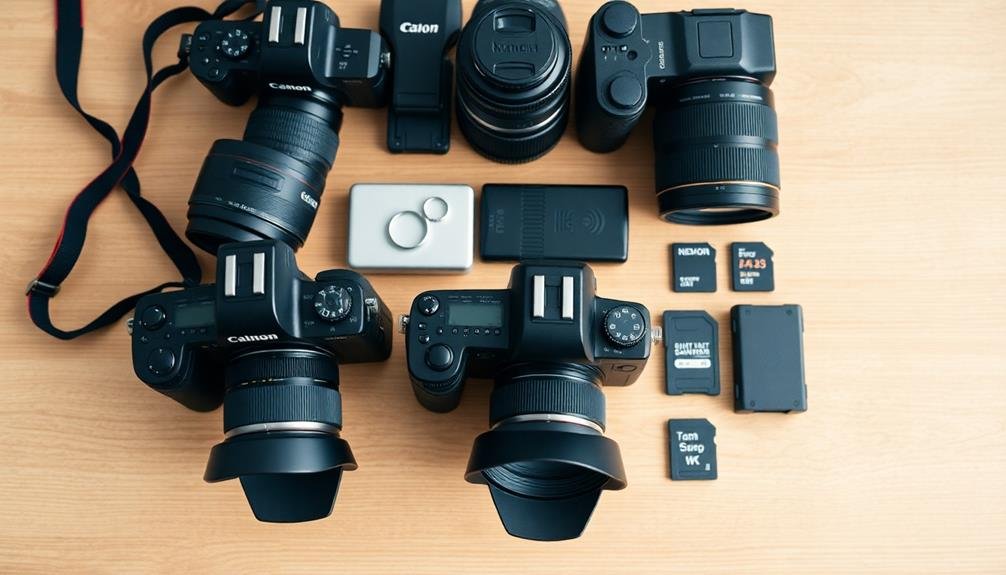



Leave a Reply